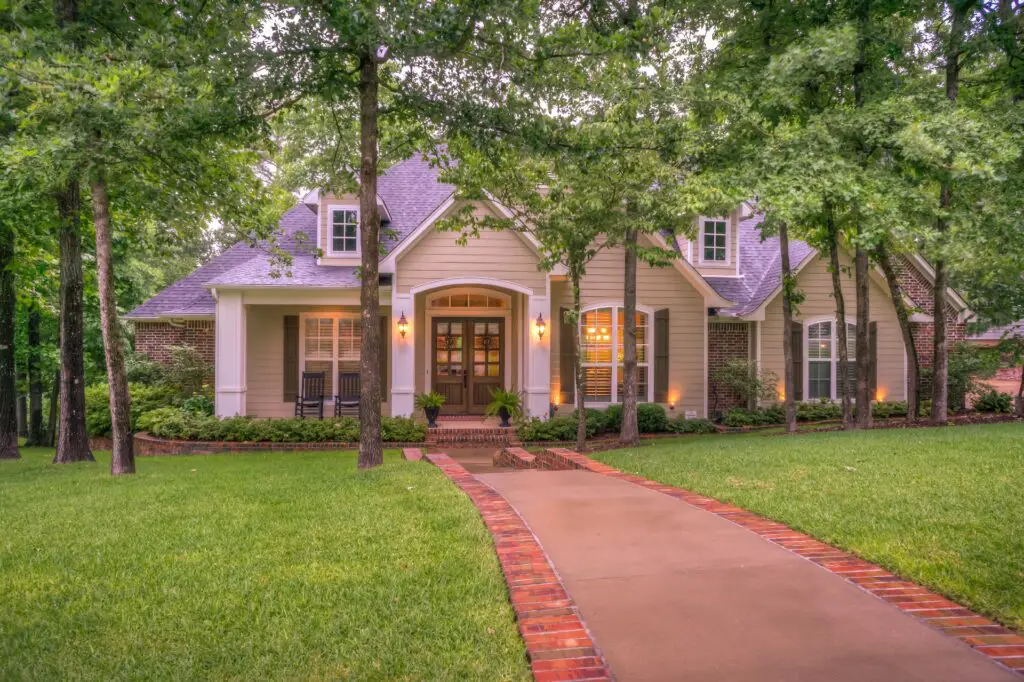The front portion of your house is a way of “presenting yourself” to the public. You should always ensure it’s beautiful and well-taken care of since it is the most exposed part of your property.
Front yard maintenance is no joke! The amount of time and energy that a typical homeowner commits to front yard maintenance can border on insane. If you want to portray your best image to neighbors and passers-by alike, then you will want a beautiful and flawless front yard landscape.
I know what you are thinking, “If only there were a way to have low maintenance front yard landscaping”. Well, it would be wonderful if someone could tell you how to have just that. As I will point out in this article, a low maintenance front yard is possible, but some of it has to do with perspective.
Table of Contents
Low Maintenance Landscaping for the Front Yard
There are many elements to consider when landscaping the front yard. And you’re about to make a good impression by giving each of these things some attention.
Still wondering if your front yard matters? Here is a bit of reading for you.
- A well-kept lawn is a prestigious symbol, with excellent yards being connected with good citizenship.
- Any front yard has the chance to become a vital area for socializing, connecting individuals, and fostering a feeling of community.
- In some places, keeping a polished front yard is something to be taken seriously. The Federal Capital Commission offered government incentives to motivate new homeowners to keep their front yards looking good routinely. This was during the development of Australia’s planned capital, Canberra, in the late 1920s.
- A wide range of plant elements creates a pleasant, friendly landscape. We will discuss low-maintenance (but lovely) plants that would be perfect for your front yard space.
Make the Biggest Impact
Whether just starting out with a blank slate, or starting with a fully established front yard, you need to start the same way. You only have so much time in the day and assuming that you are employed, you don’t have all day to sit around and maintain your front yard landscaping, even if it is low maintenance.
So, my advice to you is always start with the portion that makes the biggest impact. For some front yards, it will be one big stately tree in the front yard. For others, it will be the way that the perennial beds flank that grand walkway up to the front door. For others, it will be how the house ties into the landscape.
Whatever it is for you, this is where you need to start for several reasons. As we have learned, the front yard is important and we are being judged by it.
Before you begin the front yard maintenance, do yourself a favor and step out into the street to see what all of the hubbub is about. Actually walk or drive past your home a few times as passers-by would to get a better idea as to what is truly important.
If your time is limited, you certainly don’t want to spend the day working on a corner that doesn’t even get noticed from the street, at least not on the first day. Go out and make a big impact. Pick the most important part and start there. This way, you have made a difference to what your neighbors see, and you will feel good about your first day on the front yard.
Perspective is Important
As I mentioned earlier, having a low maintenance front yard landscape that leaves a good impression on your neighbors is important, but some of this is perspective.
You can have an impressive looking front yard without spending your weekends out in the yard, you just need to plan it properly. Unlike your backyard, where you and your guests might be strolling around or lounging on the patio, your front yard is more of a pass-through feature.
It needs to give a nice and tidy impression from the road, but it doesn’t need to be overly detailed. It is not likely that anyone will be standing in the front yard critiquing your beds, they will give a look from the road, or maybe a quick glance on their way up the driveway, but no one is looking that closely.
Don’t go crazy with the details. The majority of folks will be judging your yard from the road. Concentrate on this, not the tiny details.
Make a Good First Impression

In the spring it seems like our eyes are open just a little bit wider, it seems like we appreciate the outdoors more and everything just seems fresh. Well, maybe everything except that stale old mulch that you have laying on your beds.
A great, high impact way to improve the curb appeal of your home is by freshening up the mulch. You don’t necessarily even need to replace it all, it just may need a bit of touch up and raking.
Chances are, some of your front yard could use a bit of whatever mulch material you have used in the past, so order a bit and freshen the place up. Use care to spread it evenly and neatly and the mulch will provide a crisp, clean look and help to hold back the weeds.
Mulching can reduce soil evaporation, regulate soil temperature, conserve moisture, prevent weed development, and improve microbial activity. This will save you time later in the summer.
Get an Automated Irrigation System
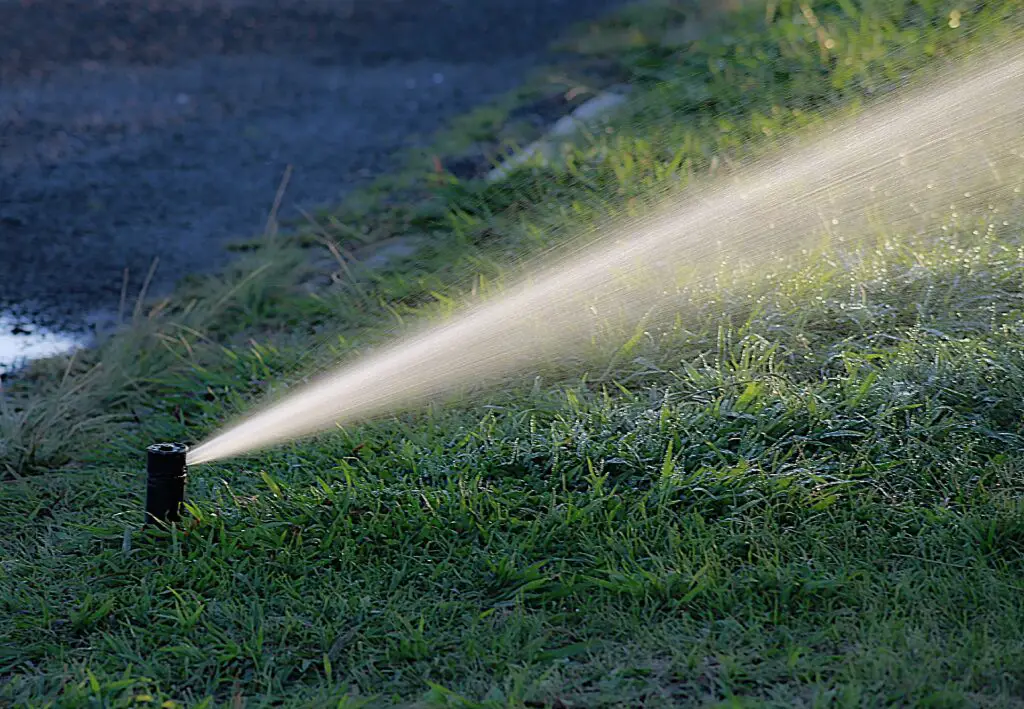
If you live in one of those areas where consistent watering is required to maintain that lush green lawn that you love, let me offer you a bit of advice. The best and highest impact thing that you could do would be to eliminate the turfgrass. If turf doesn’t grow well in your area, then your front yard will never be low maintenance no matter what you do.
But, if turf is of great importance to you and you feel it is necessary for your home to have a turf front lawn, then installing an automated irrigation system may just be money well spent. If you are relying on yourself or your children to set up and move lawn sprinklers, you are setting yourself up for failure.
Get an automated irrigation system and you can check watering off of your list of things to do.
Get one with a rain sensor, moisture sensors and a time clock so that you can schedule the lawn to be watered only when it needs it, but at exactly the correct time that it needs it. Then, be sure to set it to water the turf deeply to encourage deep roots.
Setting an automatic sprinkler to water every day or twice a day is foolish. This will create a lush green, very sensitive and shallow rooted lawn. You want those turf roots to grow deep into the soil, so water deeply, but only when absolutley necessary.
Plants that are Native to Your Area are Easy
Even though there’s a diverse selection of plants that would look amazing for your front yard landscaping, it’s best to stick to native species. Sure, browse the web for ideas, get together a bunch of pictures of how you would like the yard to look, but then figure out how to get it close to that look using only native plant species.
Sure, if you live in Wisconsin like me, you will not be able to have the brightest colored, most astonishing landscape, but I’ll bet you can get close to the look that you want while still using native plants.
By using native plants, you are greatly increasing your chances of having your weekend time to do something other than yard work. Native plants will take care of themselves, because they are very comfortable and well adapted to their surroundings. Site adaptability is very important for the survival of plants.
There’s a strong possibility that if you try to defy nature by choosing a plant that does not suit your geographical location, it will die. Plants in a suboptimal environment will be uncomfortable, prone to stress, more likely to have pests and diseases, and need more upkeep.
Plant Perennials in Your Front Yard
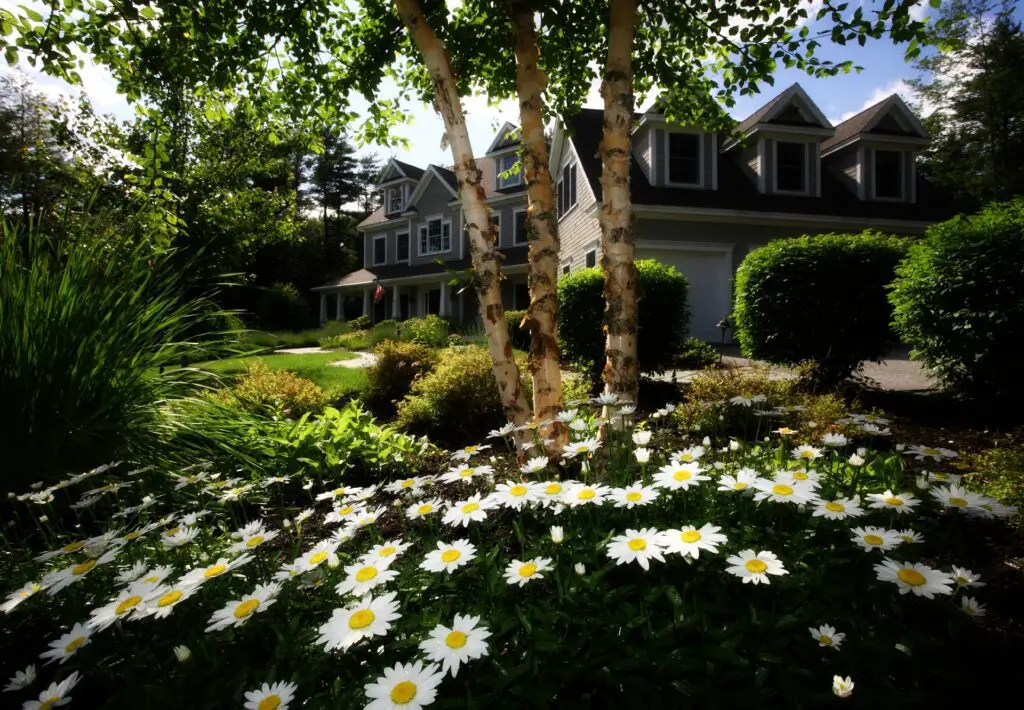
I’m assuming that you would like to see some blooms in your front yard from time to time and I am assuming that you don’t want to spend a great deal of time tending the flowers. If my assumptions are correct, you had better choose some perennials to plant in your front yard.
Once again, go for native, hardy types, but take some time to stagger bloom times and plant heights and you can have a bed that looks astounding from the street, yet takes very little time to maintain.
But what makes perennials the perfect low-maintenance plants? Perennials grow in habitats where resources are scarce, typically owing to plant competition, and they grow more slowly than annuals.
Utilize Potted Plants
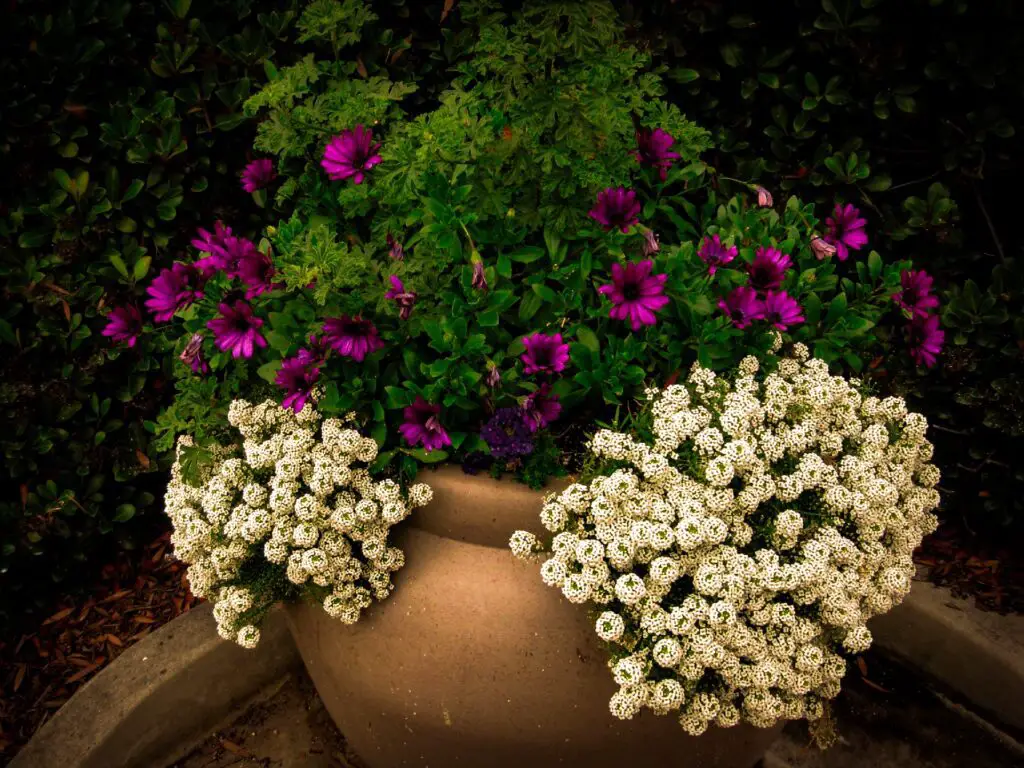
Maybe digging and cultivating aren’t high on your list of fun activities to do around the house. If you want an easy way to add a splash of color and texture to your front yard, installing a few pots filled with dazzling annual flowers might be just the thing for you.
Your front yard will benefit greatly from potted plants. They’re a great low-maintenance, adaptable option for landscape! It is proven that having decorative plants around you improves memory recall and focus. But it would certainly be nice if these plants are arranged attractively and are hassle-free.
Of course, mobile pots standing tall in the yard will need more water than plants in the ground, but if you have your automated irrigation system, you can take care of that easily enough.
If you have any sort of eye for design, you can certainly use potted plants to make a beautiful accent border or to just create a bit of color and height in a few choice areas. The nice thing about the potted plants is that you can easily rearrange them if you don’t like the way they look the first time that you lay them out.
Succulents, Ruscaceae, Araceae, spider plants, and Commelinaceae, are among the hardiest plants that survive in pots, but don’t be afraid to go crazy with the most colorful and exciting plants that you can find at the local garden center. Sure you will need to replace them every year, but buying flowers is fun and it allows you to have a different look each season.
Plant Some Annuals
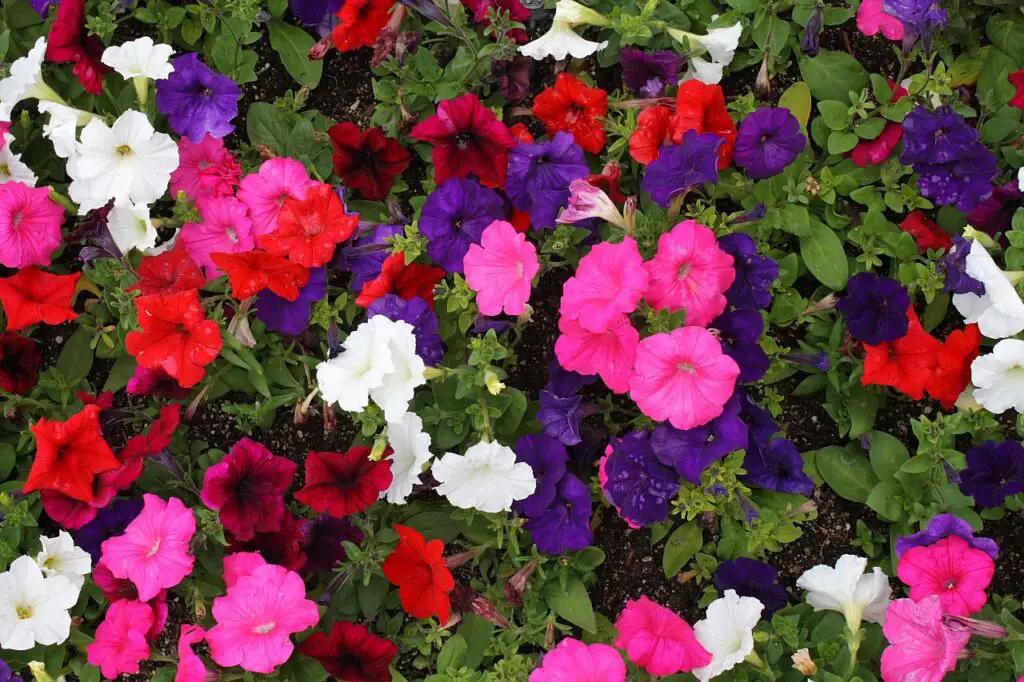
Annual flowers do need to be replaced each year, but by going to the garden center and buying a few flats of some colorful annuals, you can bring a bit of excitement and color to your yard with very little actual work.
It is fairly easy to create one of two annual areas in your front yard landscape at certain points where they are sure to draw attention and catch your eye. You can have a few larger beds, or simply plant small groups in and among the existing plants to change things up a bit.
Clumps of annuals in your groundcover beds is a sure way to liven up the look of your front yard.
Plant Some Groundcover
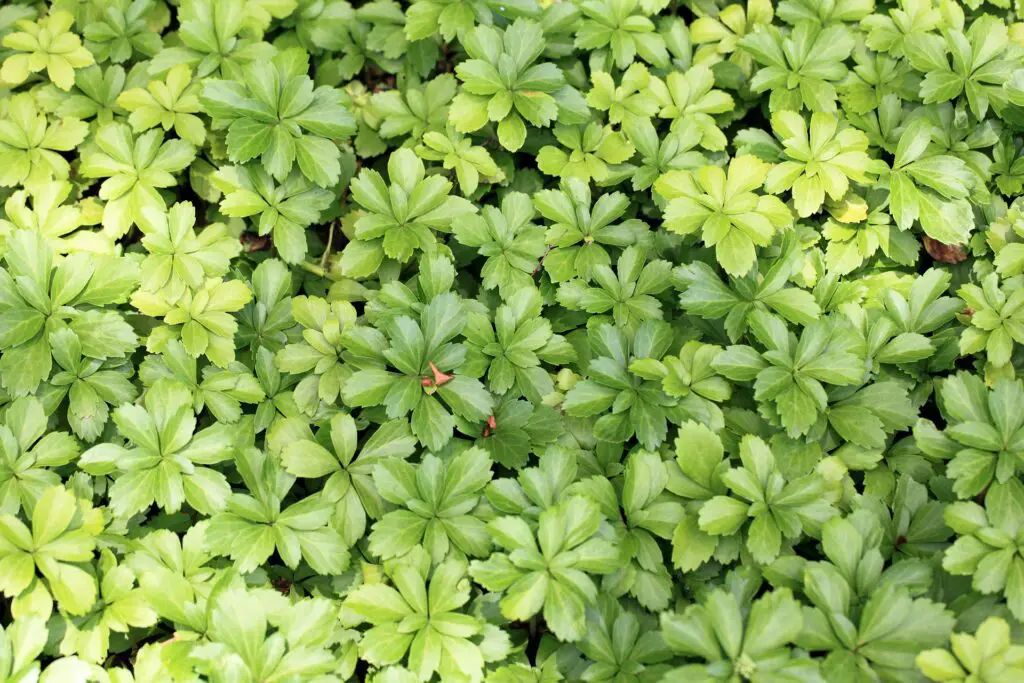
Rather than mulch, which needs refreshing and raking, planting groundcover plants can do a great job of filling your open bed areas. The groundcover plants will help to prevent erosion and they will crowd the weeds out over time which will really cut down on your time spent in the yard.
Try Synthetic Grass
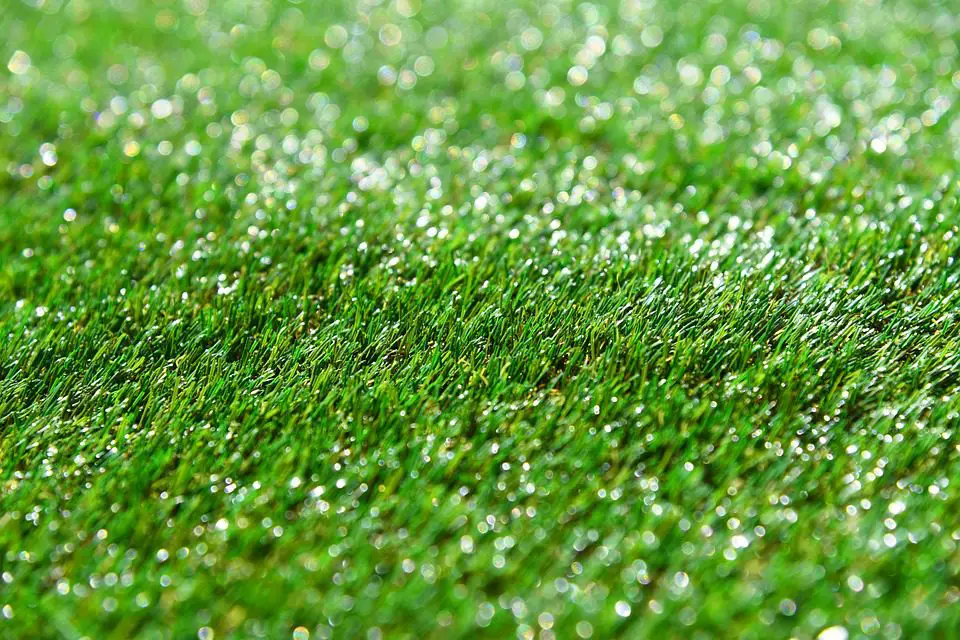
Okay, you might think that I’ve stepped off of the deep end here, but hear me out. If you live in an area that requires consistent watering to maintain turf, then might it not make a lot of sense to install fake grass instead?
What constitutes 80% of your front yard and requires the most attention? It’s the grass that needs regular upkeep. Watering, fertilization, mowing, thatching and aeration can all be things of the past if you install high quality synthetic turfgrass.
So why not try fake grass? Get one that’s greener than your neighbor’s. So when they see that the grass IS greener on the other side, you can tell them about the wonders of fake turf.
Today’s synthetic grass is not much like the stuff you remember sing that was all faded and torn up at the local mini-golf center. Some of today’s synthetic turf is hard to distinguish from the real stuff. Let’s see what it’s made of.
Depending on the color that you choose, your neighbors might not even know the difference until a drought or the fall comes and their lawns turn brown while yours looks as green as ever.
Instead of Grass, try Clover
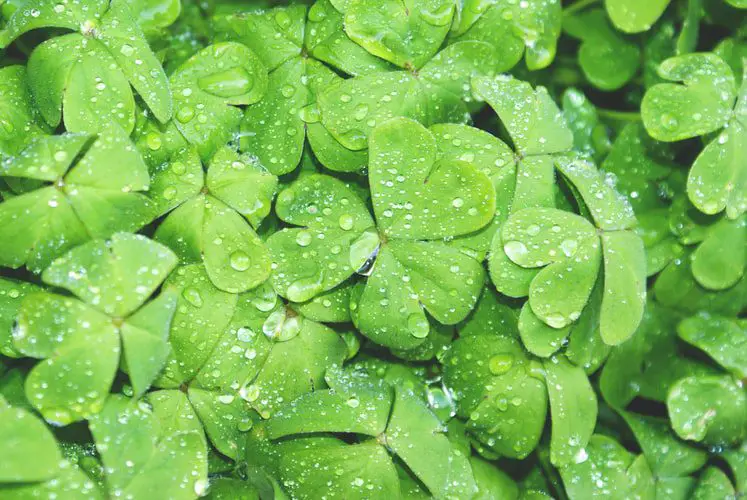
There are several reasons to have a clover lawn! If you’re tired of the expensive and time-consuming nature of the usual grass lawns, give clover a try.
Clover fixes nitrogen, which benefits plants close to it. And because clover has deep roots, it doesn’t have as high a water requirement as regular grass. It also doesn’t need fertilizer and rich soil; it’s not a very picky plant!
Clover is a sustainable lawn replacement. And if you don’t want your lawn to be completely covered (clovered?) in clover, you can gradually incorporate it into compatible grass.
Clover is also great for wildlife.
Consider Xeriscaping
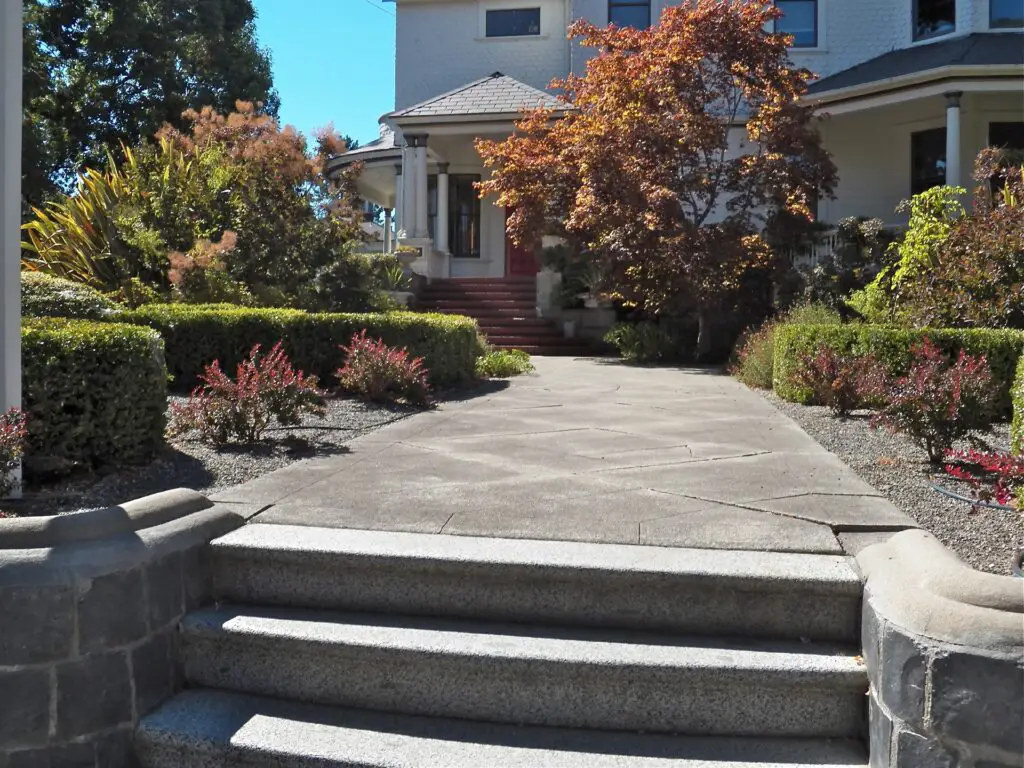
Another low-maintenance practice you can do for your front yard is xeriscaping.
Xeriscaping aims to decrease or eradicate the requirement for watering in the landscape. This implies that xeriscaped landscapes only require as much water as the natural climate allows.
But take note that because of cultural standards and a total absence of landscape knowledge, the public’s impression of xeriscaping is often unfavorable, with some supposing that these landscapes are unattractive stretches of cactus and gravel. To prove this wrong, you have to have an eye for design and choose the right plants.
This is all about figuring out how to make a beautiful front yard that doesn’t rely on you to look beautiful. This goes back to our premise that there are better things to do that labor in your front yard for the weekend. Xeriscaping isn’t any particular type of plant or look, it is simply drought tolerant choices and groundcovers that will thrive and last in your climate.
Xeriscaping in your part of the world will look quite different than the xeriscaping in another part of the world.
Lay a Strong Foundation
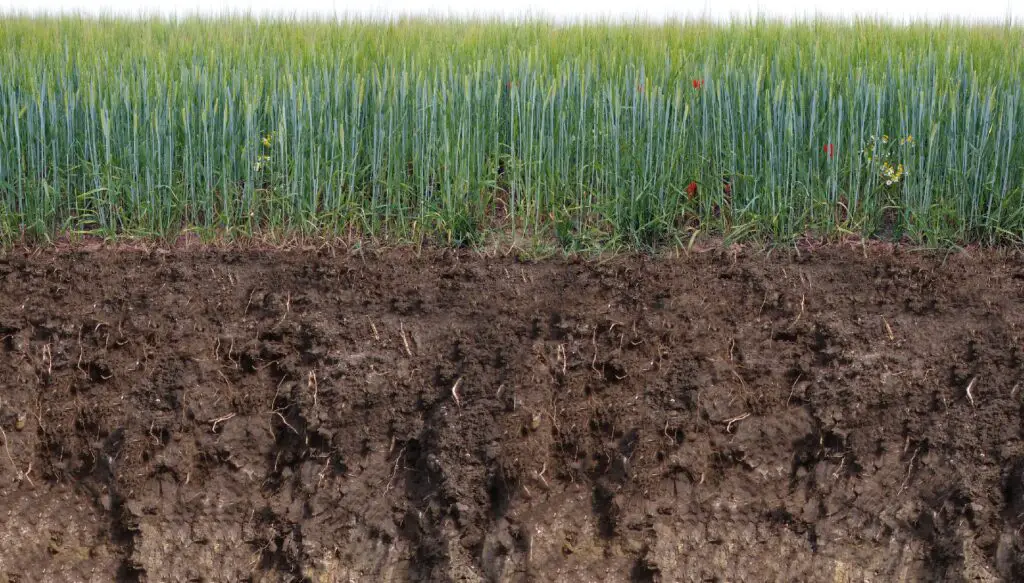
Low maintenance requires a strong foundation. If you are starting a new front yard landscape, don’t be a fool and skimp on the foundation. the foundation is what everything is built upon.
For your home, the foundation is likely concrete. For your driveway and walkways, the foundation is likely crushed stone and for your plants and yard, the foundation is the soil.
New or old, the foundation that you begin with will dictate the long term maintenance and feel of your finished yard.
If you skimp on the foundation of any of these areas, the features that they support above will falter given time. Driveways will crack and settle, walkways will dip and roll and garden plants and trees will lose vigor when planted into and on top of poor quality soil.
In each one of these cases, the foundation is important. If you have an existing house and landscape, then you may be stuck with what the prior owner did, but if you are planning a new front yard landscape, invest in the foundations, it will pay off in the end.
When you establish a good, sturdy foundation, you’re going to be set for decades! You can forget about mundane tasks like picking up stones, removing weeds from walks, fixing cracked driveways, filling potholes, and fertilizing plants.
Choose Some Stone
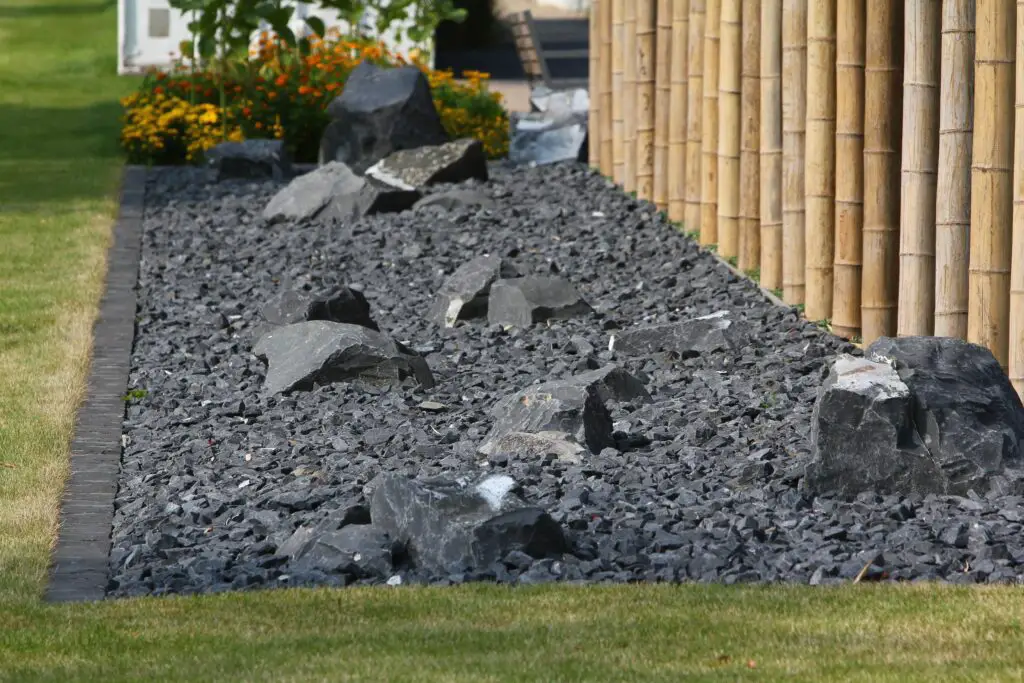
Stone in landscaping beds has always been common in low-maintenance front yards. Placing stones is a fantastic one-time activity. Stones do not need to be replenished after they have been set and they can last for many years with very little attention.
Adding the proper stones can make a difference! It’s a way to add a different texture and a touch of color to an otherwise lacking scenery. My suggestion would be to bring home some buckets of sample stones that are available in your area and lay them out to see how they will look in your yard.
For instance, a sprinkling of river stones creates a discreet but noticeable border between the garden bed and the grass. These stones will beautifully contrast with the green of the front yard (don’t get green rocks, though).
But when you choose stones, once again think about foundations and longevity. Lay down the best landscape fabric that you can afford underneath it and be sure that you lay down at least two inches of stone to make sure that you aren’t looking at the weed barrier in a few months.
Build a Rock Garden
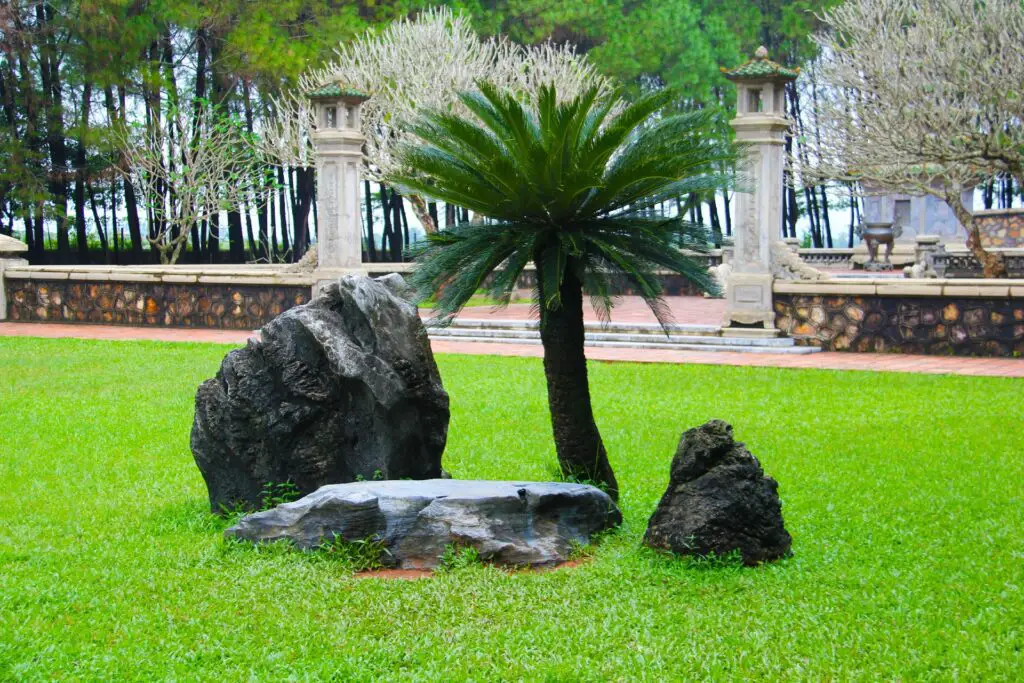
Even though it’s a garden, the rocks won’t grow, so be sure to buy them big enough to make a statement and so that they can be seen from the road. Big rocks can really make a statement. Each one is unique and they add structure and color to a front yard landscape.
Plant your rock garden with drought resistant, creepy, crawly plants. The only maintenance that you are likely to need will be trimming away some of the plants over time to expose more of the rock.
Drought-resistant plants that don’t demand much monitoring are common in rock gardens. Furthermore, the rocks themselves are décor that does not require any watering or maintenance and nevertheless have a natural aesthetic appeal similar to plants.
Use Succulents as a Backdrop

This will only work in areas that will readily support their growth, but if you live in one such area, then succulents might just be a great way to minimize your maintenance.
Cacti (Cactaceae) and succulents have a morphology that has been developed to save water. They don’t require as much attention as other front yard plants due to their tolerance to dry conditions. But that’s not all! You have a wide variety of colors, shapes, and sizes for these plants. You can pick anything that catches your eye!
And if you just can’t get enough, you can just as easily grow another one by propagating. It only takes one snip.
Even in the hottest of summers, you can count on your succulents to keep your front yard looking fresh.
Careful Plant Selection can Help Control Soil Erosion
Some areas are blessed with proper drainage and minimal runoff, so if your home is in one of these areas, then this section won’t apply to you. But, if you live in a place where storms bring erosion, then it is paramount that you find a solution to your erosion problems before you do anything else.
There is no sense in doing any of the detailed work until your erosion is under control. Having nature wash your landscaping away is definitely not low maintenance. As a matter of fact, needing to start over when it all washes away sounds like to opposite of low maintenance.
Plants with large root systems can do all of the work in controlling soil erosion. They keep the soil intact, absorb water, and protect the ground from wind and water exposure.
But did you know? The microscopic hairs present on plant roots serve an important role in reducing soil erosion. They do so by enhancing soil cohesion.
Why is soil erosion a big deal?
Having plant covers is one of the most efficient strategies for erosion control and regenerating previously damaged soil. Creeping juniper (Juniperus horizontalis), creeping phlox (Phlox stolonifera), and Cotoneaster are good examples of some erosion-controlling ground covers for the front yard.
Add Low-Maintenance Flowers for a Beautiful Landscape!
It’s been scientifically proven that flowers are a natural and healthy mood stabilizer. Earlier, we talked about how important perennial flowers can be to your low maintenance front yard. The presence of flowers in the front yard is a must! There are many flowering plants that don’t demand a lot of care and attention, but here are a few you can get familiar with.
Lavender (Lavandula angustifolia)

Plant lavender. This stunning flowering plant will give your front yard a splash of color and a soothing scent.
Lavender is a low-maintenance plant that needs little watering and trimming once established. You can do so much with lavender plants! You can use them as informal hedges, as a walkway border, or even as companion plants.
For example, you can strategically place lavender in front of rose bushes to cover their bare stems.
Common bugle (Ajuga reptans)
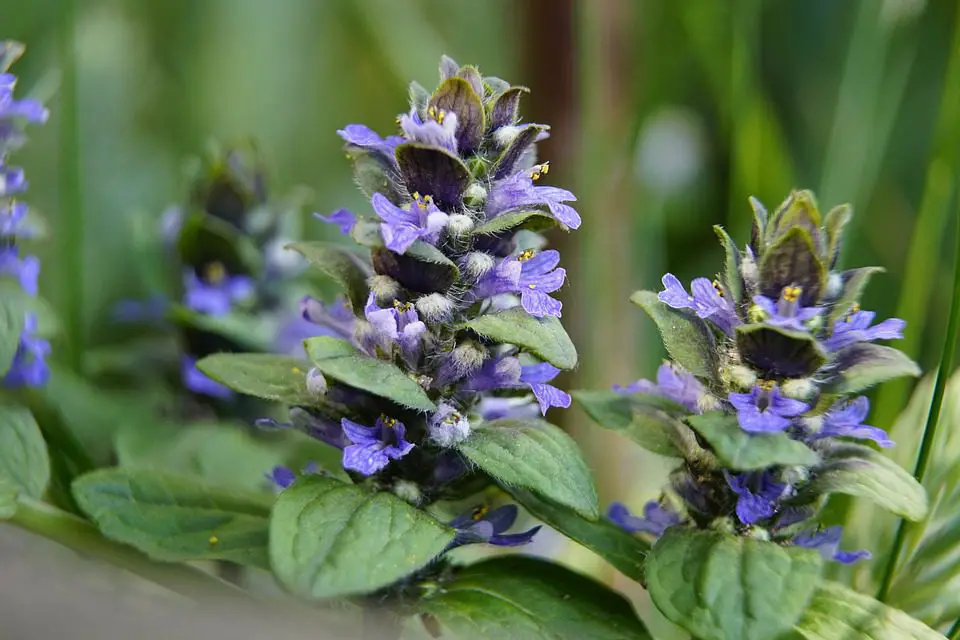
Bugleweed and Carpetweed are other common names for this plant. This would look great in your front yard with its upright growth habit gives its bloom arrangement a unique look.
Its purple and blue flowers set out in an upward direction will surely grab attention. But it does not demand your attention when it comes to upkeep! For you only need to cut unruly stalks and dig up some runners two times a year.
Periwinkle (Vinca Minor)

Vinca minor, often known as periwinkle, is certainly a beautiful, low-maintenance blooming plant you can grow in your yard.
It does not just provide an amazing backdrop; it also helps in weed control! Expect purple flowers in spring and summer. Even its foliage is pretty—shiny, dark green, and nicely rounded. You can even use this plant as a groundcover.
What makes this plant low-maintenance is its root system which quickly spreads. This plant can take the heat and the shade, but it does best in part to full sun.
Coreopsis

Coreopsis thrives in well-drained soil and can be grown as a border plant in the front yard. You can even grow it in containers!
The only upkeep this plant needs is deadheading the blooms. If you do this, you prevent the plant from becoming weedy.
Check the USDA Hardiness Zones to determine which climate and soil are best for particular varieties.
Dianthus
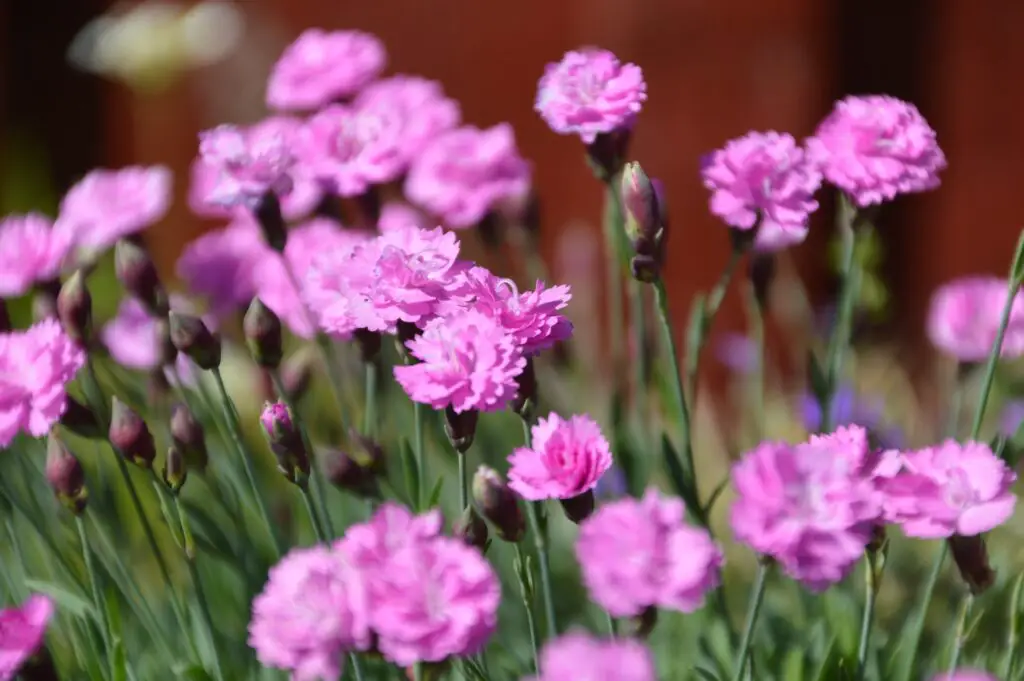
Dianthus, also known as Carnations (D. caryophyllus), Sweet Williams (D. barbatus), and Pinks (D. chinesis), are a favorite front yard flowering plant.
They are great for your low-maintenance front yard landscape because of their wonderfully scented, fringed flowers in shades of pink, red, and white and because of their deer resistance! It’s also nice that they multiply easily.
Daylilies
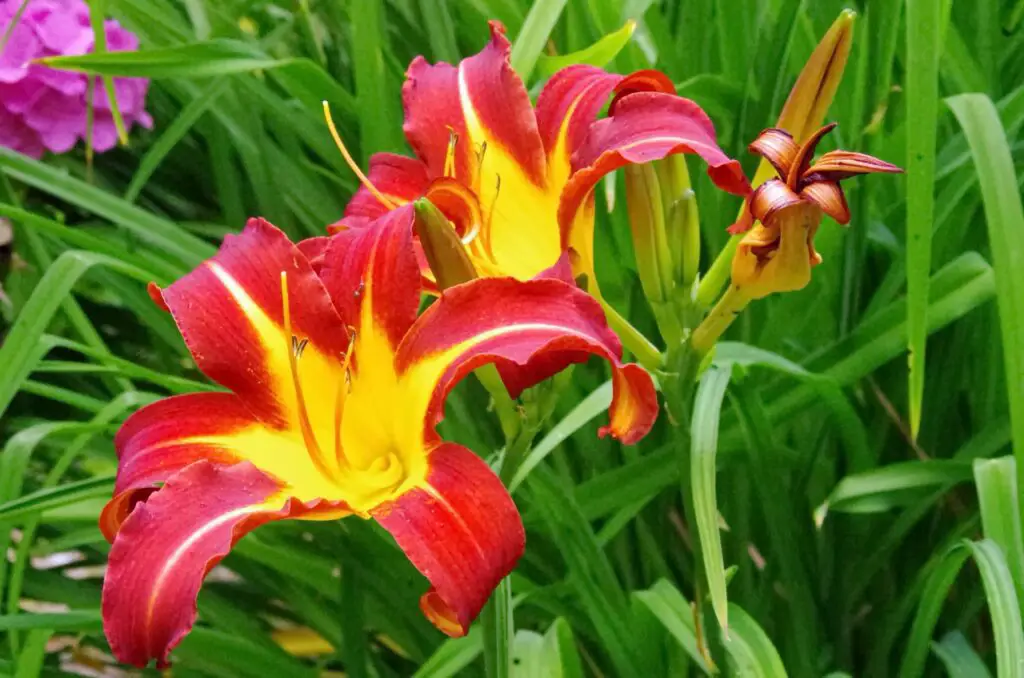
Daylilies come in many different varieties and bloom times, they grow like crazy and can choke out weeds in your beds.
Not only do they provide great color, they help to reduce weeding. What could be better.
Hostas
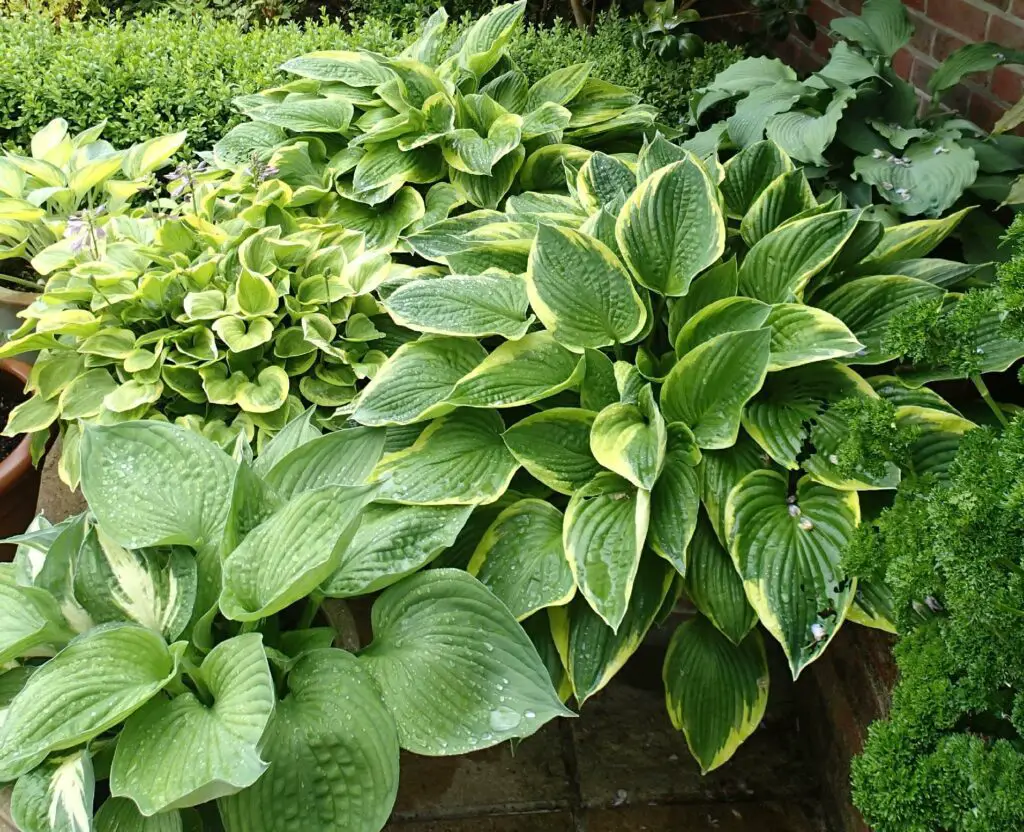
If you have some shade in your front yard, then a rich and beautiful bed of various leaved hostas can really make a profound statement.
Hostas don’t like much sun, so you do need some shade. There are hostas of many sizes, colors and leaf textures, so create a nice mix of these hardy, weed snuffing plants to help with your yard maintenence.
Roses

Now many of you will think that I am nuts for even listing roses in a low maintenance article, but that is why I couldn’t’ resist. Contrary to what you may have been taught, there are many roses, that when planted in a suitable location, can grow readily and beautifully on their own.
Be sure to pick the hardiest varieties that you can for your area and go for a nearly wild climber if you really want some fun.
Rose blooms can be wonderful if you can get the right variety for your yard.
Black-Eyed Susan (Rudbeckia hirta)
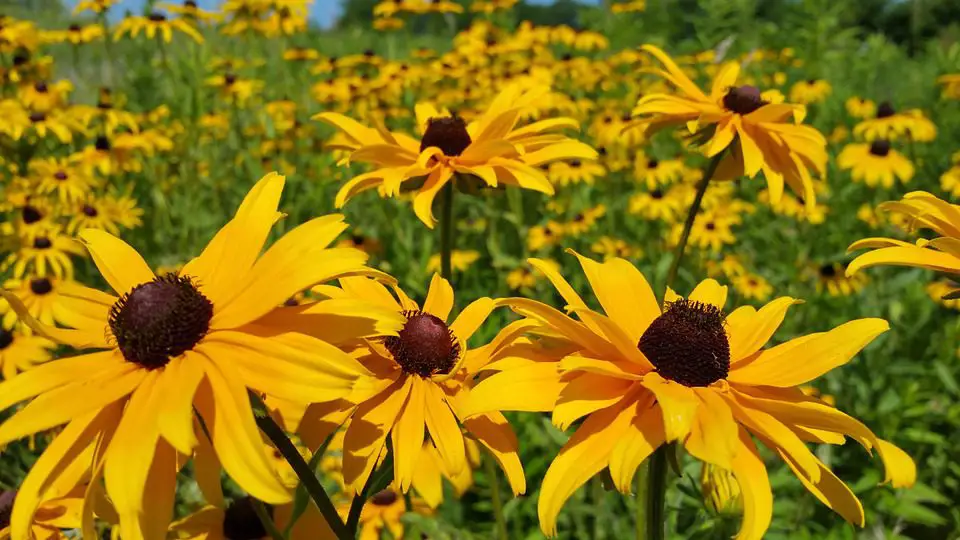
It’s a great idea to plant Black-eyed Susans in your front yard. Aside from beautifying your yard with its flowers, another reason you’ll like Rudbeckia hirta is that it is native to most of the United States.
Various sizes and colors, including reds, oranges, and browns, have resulted through widespread hybridization. So this leaves you with plenty of options!
Plant Trouble-Free Shrubs for a Low-Maintenance Landscape
Shrubs play an important role in the ecosystem of any yard. These plants offer shade, increase soil integrity, help out animals, and improve air quality. Pretty important, right?
Here are some front yard shrubs you can’t go wrong within low-maintenance landscaping.
Forsythia

Forsythias are low-maintenance plants with yellow blooms that indicate the arrival of spring. You’ll only want to trim your forsythia shrub now and then and put it in full sunshine to keep it in good shape.
Forsythias are adaptable, and you’ll enjoy seeing their lovely flowers early in the spring.
Weigela (Weigela florida)
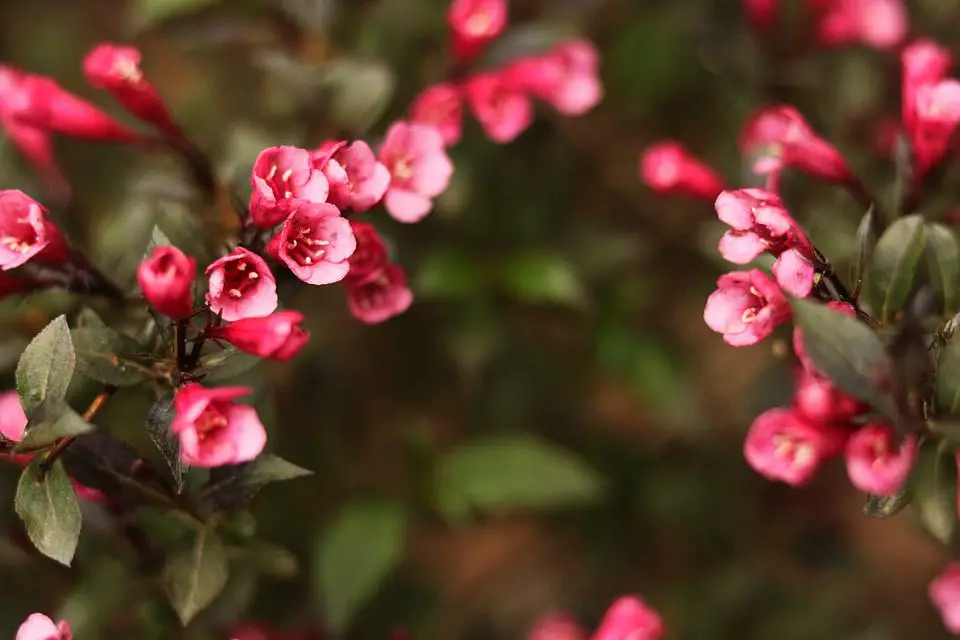
Florida is not just a state; it is a word that means “profusely flowering.” And if there’s one flower that deserves to have florida in its scientific name, it’s Weigela! You’ll be in awe when you look at your front yard and be greeted with the sight of these gorgeous pink (or white, or rose-red) flowers.
Weigela florida is easy to care for since it’s not prone to serious diseases or pests. Furthermore, it can handle even clay soils. Although, the ideal conditions are full sun in well-drained, moderately moist, fairly average soils. You won’t have a problem maintaining this plant!
Yew (Taxus spp.)
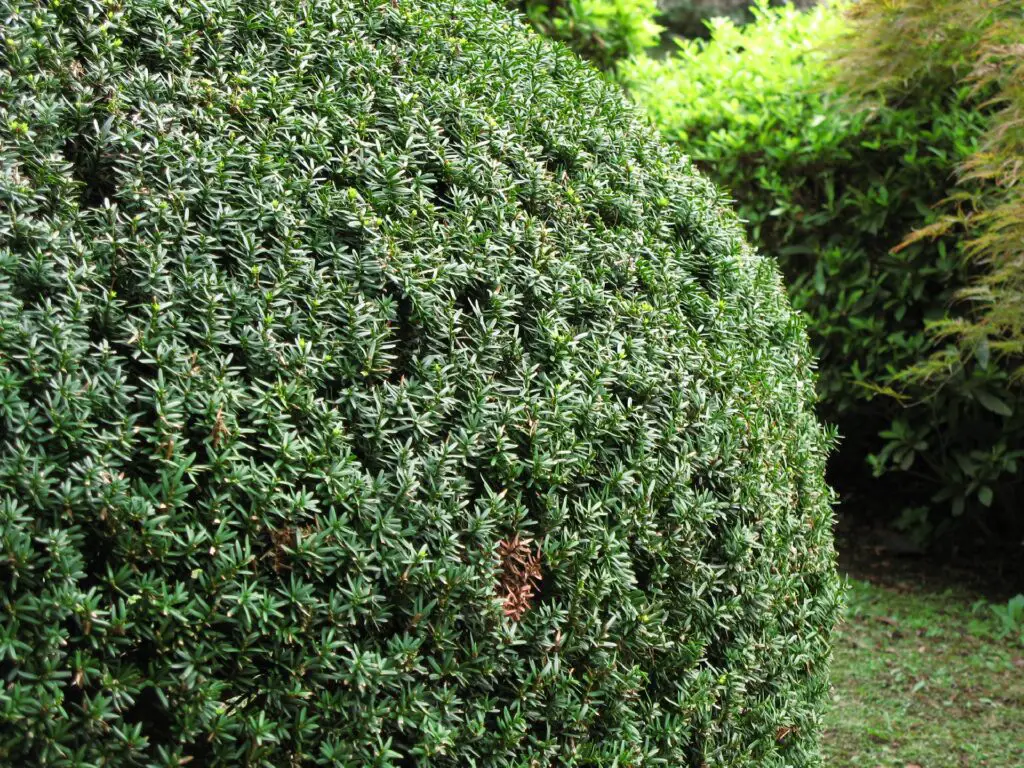
Yew bushes require very little care due to their drought tolerance and acidic soil adaptability. They’re the most basic plant to cultivate in the front yard. These plants can grow into a thick hedge that may be trimmed neatly, and it’s popular in the topiary.
This species of plant has existed for more than 200 million years! They live for a very long time.
Yews flourish in Zones 4 to 7 in part to full sunlight and produce lovely-looking fruits early in the fall.
Rockspray Cotoneaster (Cotoneaster horizontalis)
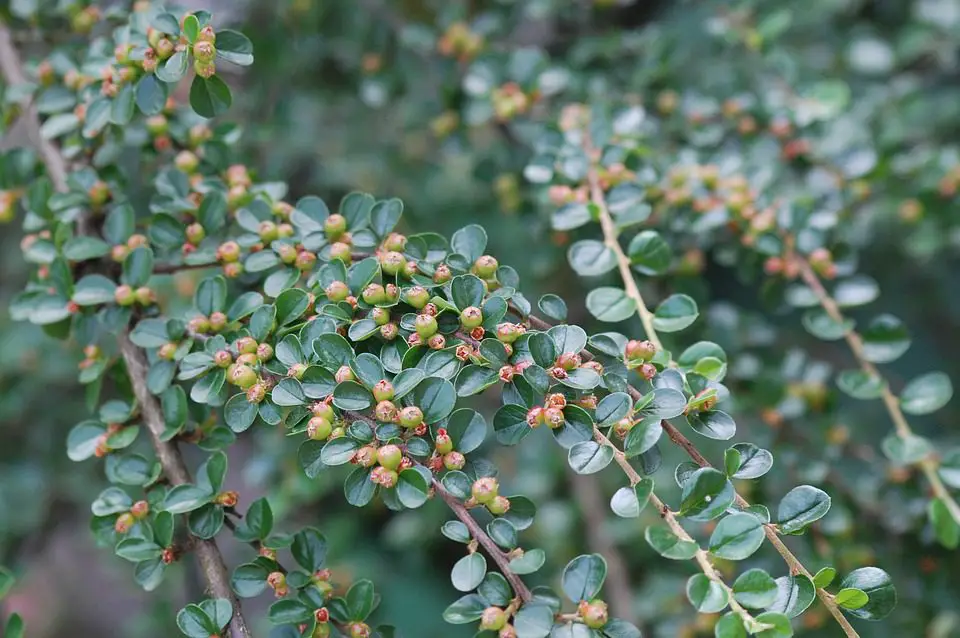
The best thing about Rockspray Cotoneaster is its adaptability to any type of soil. It can withstand the poorest of soil conditions! It also has a self-supporting growth habit.
Rockspray cotoneaster is a coarse, thick, slowly growing shrub that grows to a height of 2-3 feet and a width of 6-8 feet. You’ll want it in your front yard for its four-season interest.
Rockspray cotoneaster shrubs are easy to grow and care for. You just have to plant them in spring to let the root system fully establish.
Texas sage (Leucophyllum frutescens)
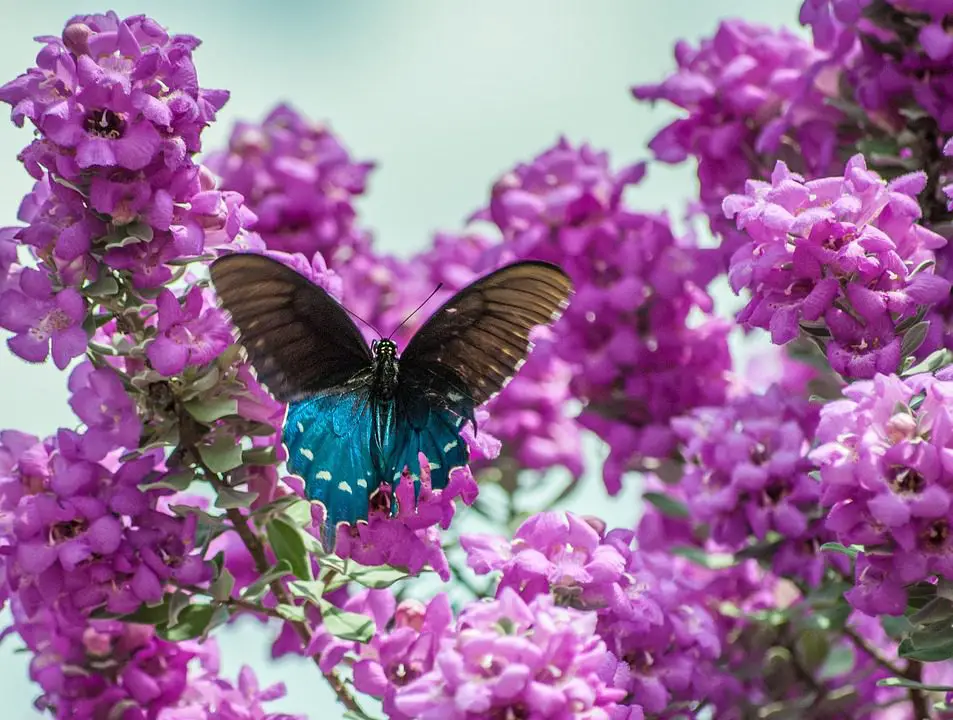
This Texas native plant is sometimes known as purple sage or Texas Silverleaf. Their leaves are thickly coated with silvery hairs, giving them a gray appearance.
It is a non-fussy evergreen coastal shrub with beautiful purple flowers! It favors an environment with low humidity, but it can withstand drought and heat well. And once it’s fully established, you won’t have to worry about its upkeep.
Goldthread cypress (Chamaecyparis pisifera ‘Filifera Aurea’)
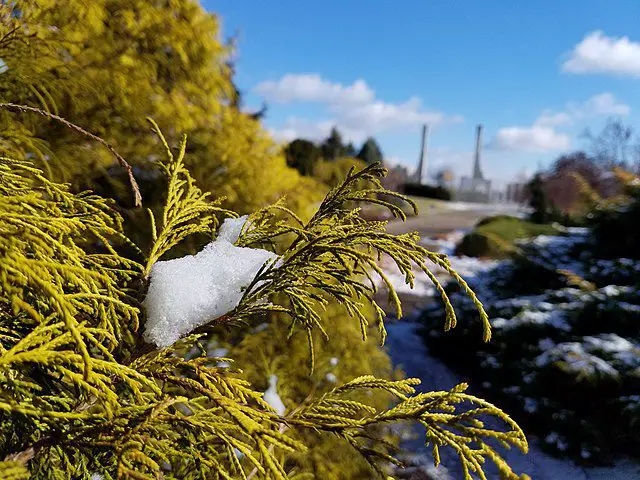
The Goldthread cypress is a non-flowering shrub. Its beauty lies in its thread-like, needled foliage that boasts a vibrant yellow color.
It’s hardy to zone 4, and it needs moderate sun exposure (too much sunlight can damage the leaves).
Because this shrub does not look good with columnar plants, you should put it near wide-spreading plants.
Bottlebrush Buckeye (Aesculus parviflora)
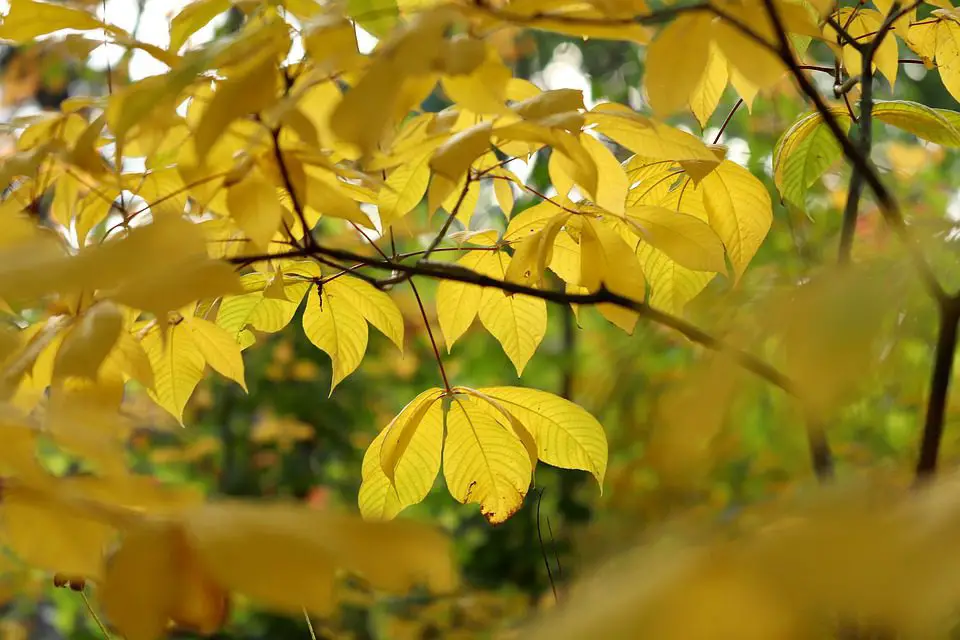
If you live somewhere shady, this is one of the finest summer-flowering shrubs you can add in the front yard. This deciduous shrub’s got a great thickness and height (6-12 feet tall). Plus, its suckering, upright form, and white flowers will stand out.
You’ll like this plant for its slow growth, which means you don’t have to care much about pruning it. It’s also quite disease-free!
Its luxuriant leaves become a gorgeous gold in autumn, which will certainly brighten up your front yard.
Boxwood (Buxus)
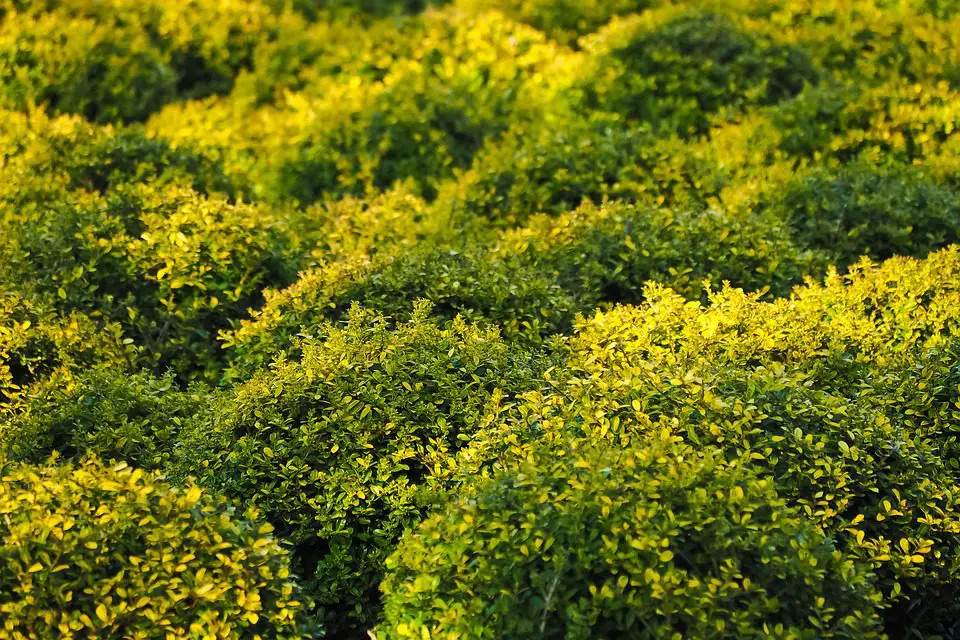
Incorporate a simple but tasteful boxwood hedge anywhere in your front yard. The dense foliage of boxwood shrubs may be readily sculpted into various patterns, despite looking basic at first. Boxwood is commonly preferred in its stunted form, but if permitted to grow freely, it may reach a height of 12–15 feet.
Try it! They would effectively beautify and accentuate any feature of the landscape you like.
Barberry (Berberis vulgaris)
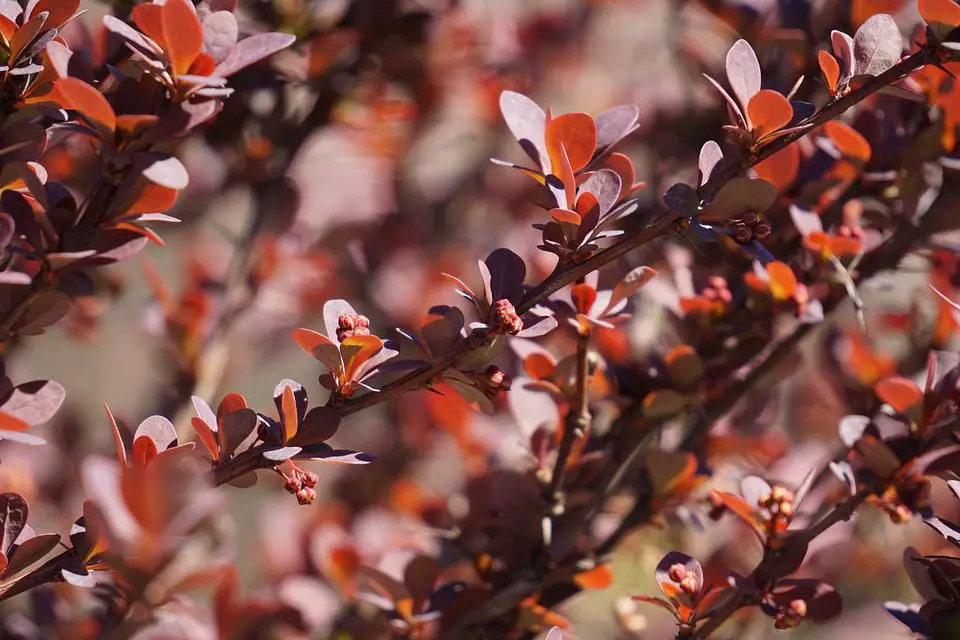
It is a deciduous shrub that can grow up to 10 feet in height. If you’re considering planting barberry in the front yard, there’s not a lot of reasons not to! It will look nice and lively all year because of its attention-grabbing, colorful foliage. Who wouldn’t want shades of orange, red, and yellow in their yard?
It is a hardy plant, too! It can survive in temperatures as low as 40 °F. This makes it such a staple in every front yard.
Fuss-Free Grasses can do a lot for the Landscape
Which grasses are native to your area? Native grasses are the best choices for low-maintenance grass. It depends on your location, so doing a little research wouldn’t hurt!
Anyway, here are a few examples of nice, easy-care grasses for your front yard.
Chinese Silver Grass (Miscanthus sinensis)
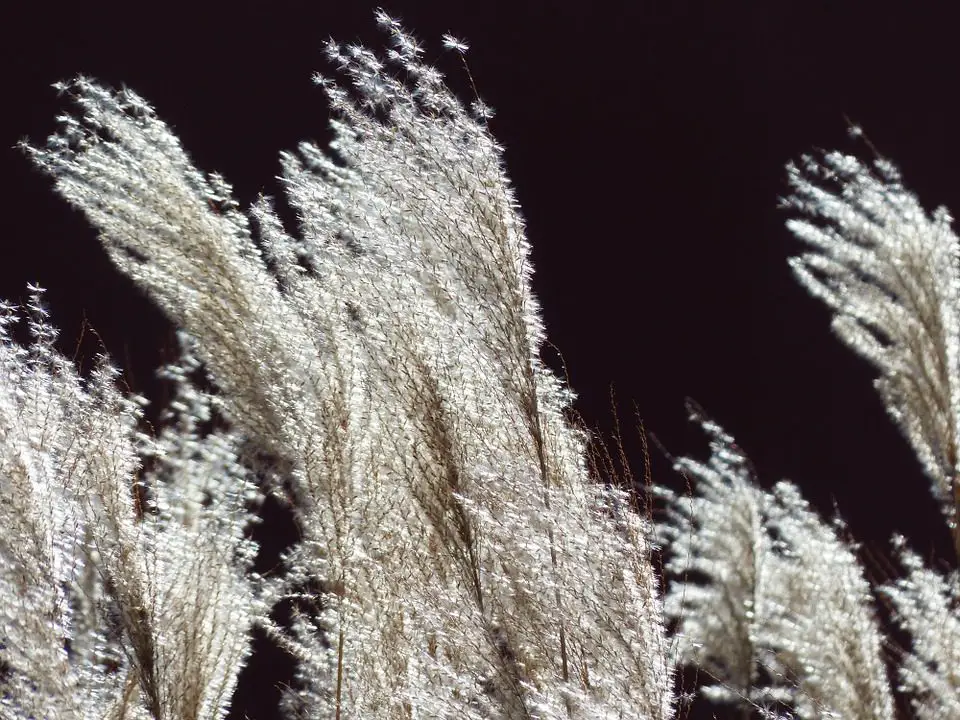
Chinese Silver grass belongs to the Poaceae family. It is still a renowned decorative plant in several parts of the US. It also acts as a barrier plant surrounding the sides of roads and in agricultural fields.
There’s a variegated variety of this plant called Miscanthus sinensis ‘Variegatus.’ It forms a huge cluster of strongly serrate 3-4′ long leaves that creates attractive grass. You can see the variegation is in white stripes running vertically.
The best thing about Chinese Silver Grass is its adaptability to all soil types. It can also adapt to partially shady areas even though it prefers to be in full sun.
Bermudagrass (Cynodon dactylon)

This plant is a warm-season perennial. It will do well in your place if your summers are hot and the winters are mildly cool.
Mondo Grass (Ophiopogon japonicus)
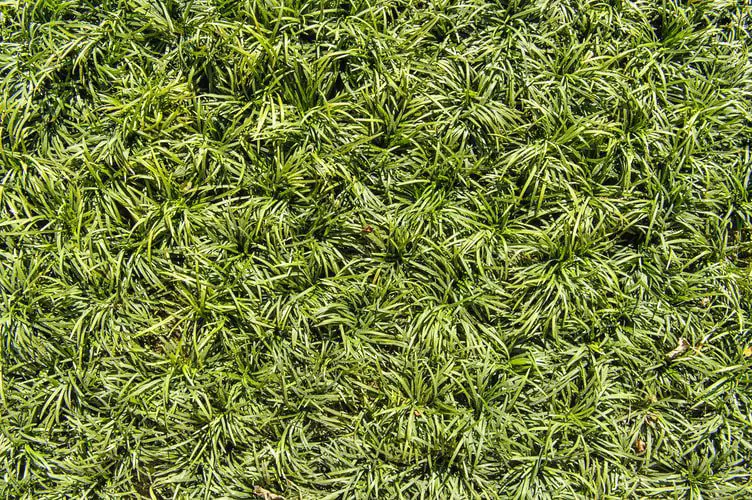
Mondo grass, also known as monkey grass, is a perennial, too. Its scientific name comes from the Greek words ophis, which means snake, and pogon, which means beard, and most likely refers to the flower spike.
Having this grass in your front yard will ensure you don’t need to mow a lot. It won’t just look great in the front yard, though! You can spice up your rock garden or flowerbed with Mondo Grass.
Fountain Grass (Pennisetum spp.)
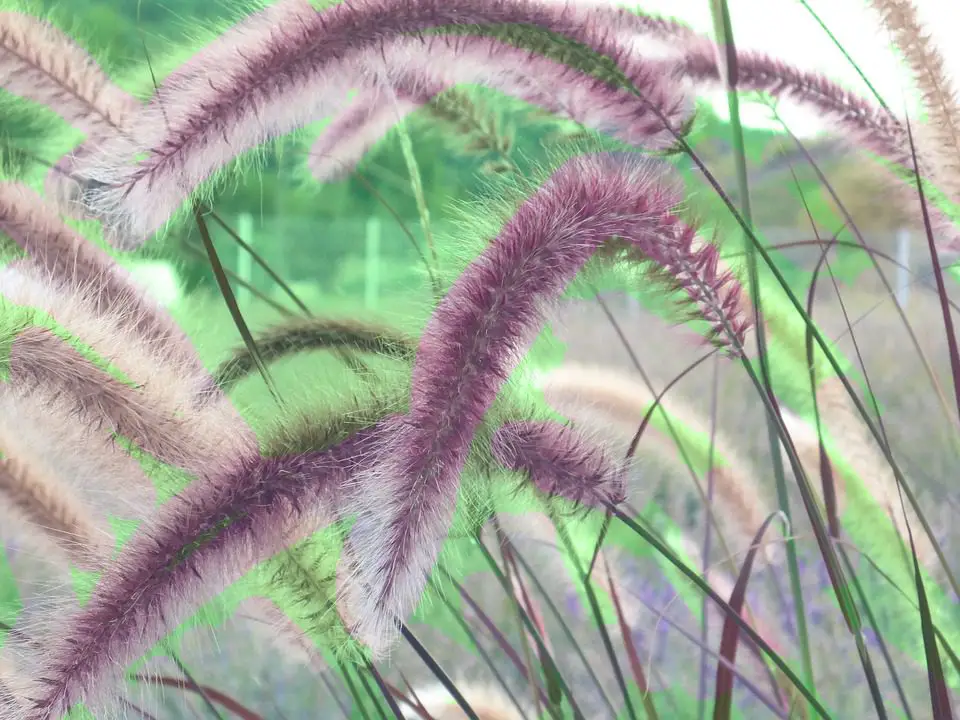
Fountain grass is decorative grass that may be seen in the front yards of houses, shops, and golf courses. You can totally use it as a specimen plant in the front yard if you’re too afraid of it becoming invasive.
You can’t go wrong with fountain grass because it is low-maintenance and highly adaptable—it does not even need frequent watering.
REFERENCES
https://d31kydh6n6r5j5.cloudfront.net/uploads/sites/75/2019/05/BrennerMcFaddenWirshing.pdf
https://meridian.allenpress.com/jgb/article-pdf/14/2/177/2403328/i1943-4618-14-2-177.pdf
https://books.google.com.ph/books?id=WTYYYrLKn1MC&redir_esc=y
https://extension.tennessee.edu/publications/Documents/W175.pdf
https://bnrc.springeropen.com/articles/10.1186/s42269-020-00290-3
https://journals.plos.org/plosone/article?id=10.1371/journal.pone.0198546
https://newswire.caes.uga.edu/story/3748/Drowning-plants.html
https://extension.psu.edu/choosing-plants-wisely
https://www.researchgate.net/publication/39762916_Plant_Physiological_Ecology
https://serc.carleton.edu/integrate/teaching_materials/food_supply/student_materials/1102
https://doi.org/10.1016/B978-0-12-817732-7.00015-8
https://plantbiology.siu.edu/facilities/plant-biology-facilities/greenhouse/topics/house.php
https://pubsapp.acs.org/cen/science/87/8709sci2.html
dx.doi.org/10.1371/journal.pone.0045926
https://journals.ashs.org/hortsci/view/journals/hortsci/54/5/article-p824.xml
https://www.nationalgeographic.org/encyclopedia/xeriscaping
https://www.science.org/lookup/doi/10.1126/science.aau6974
https://plantbiology.siu.edu/facilities/plant-biology-facilities/greenhouse/topics/cacti.php
https://forestry.usu.edu/trees-cities-towns/tree-care/mulching-tree-health
dx.doi.org/10.1038/s42003-020-0886-4
https://hal.archives-ouvertes.fr/hal-00886458/document
scholarworks.montana.edu/xmlui/bitstream/handle/1/5708/31762100149390.pdf?sequence=1&isAllowed=y
https://plants.ces.ncsu.edu/plants/phlox-stolonifera/
https://ucanr.edu/blogs/blogcore/postdetail.cfm?postnum=22348
https://www.ncbi.nlm.nih.gov/pmc/articles/PMC3612440/
https://newcropsorganics.ces.ncsu.edu/herb/lavender-history-taxonomy-and-production/
www.misin.msu.edu/facts/detail/?project=misin&id=64&cname=Common%20bugle
https://landscapeplants.oregonstate.edu/plants/vinca-minor
https://plants.ces.ncsu.edu/plants/vinca-minor/
https://plants.usda.gov/home/plantProfile?symbol=COREO2
https://landscapeplants.oregonstate.edu/plants/weigela-florida
www.missouribotanicalgarden.org/PlantFinder/PlantFinderDetails.aspx?kempercode=c367
https://gardeningsolutions.ifas.ufl.edu/plants/ornamentals/dianthus.html
powo.science.kew.org/taxon/urn:lsid:ipni.org:names:223740-2
www.efloras.org/florataxon.aspx?flora_id=1&taxon_id=200024393
https://extension.umn.edu/trees-and-shrubs/forsythia
https://www.soils4teachers.org/soil-and-environment/
https://www.nrcs.usda.gov/wps/portal/nrcs/detail/?cid=nrcs143_023553%20
dx.doi.org/10.1016/j.tplants.2018.03.004
https://dx.doi.org/10.14288/1.0107280
https://www.britannica.com/plant/yew
https://www.nrcs.usda.gov/Internet/FSE_PLANTMATERIALS/publications/idpmcpg13144.pdf
hort.ufl.edu/database/documents/pdf/tree_fact_sheets/taxbaca.pdf
https://plants.ces.ncsu.edu/plants/cotoneaster-horizontalis/
https://plants.ces.ncsu.edu/plants/leucophyllum-frutescens/
https://landscapeplants.oregonstate.edu/plants/chamaecyparis-pisifera-filifera-aurea
https://landscapeplants.oregonstate.edu/plants/aesculus-parviflora
https://www.bellarmine.edu/faculty/drobinson/Boxwood.htm
griffingarden.latech.edu/PlantPDFs/08%20Littleleaf%20Boxwood.pdf
https://www.ncbi.nlm.nih.gov/pmc/articles/PMC4678494/
https://www.ars.usda.gov/ARSUserFiles/50620500/Barberry/pdp_thesis.pdf
https://agris.fao.org/agris-search/search.do?recordID=US19860024969
https://plantscience.psu.edu/outreach/plant-id/grasses
https://www.se-eppc.org/manual/MISI.html
https://www.bellarmine.edu/faculty/drobinson/ChineseSilvergrass.asp
https://www.cabi.org/isc/datasheet/17463
https://aggie-horticulture.tamu.edu/plantanswers/turf/publications/Bermuda.html
https://turf.purdue.edu/fountain-grass/
https://www.nps.gov/sagu/learn/nature/fountain-grass.htm/index.htm

